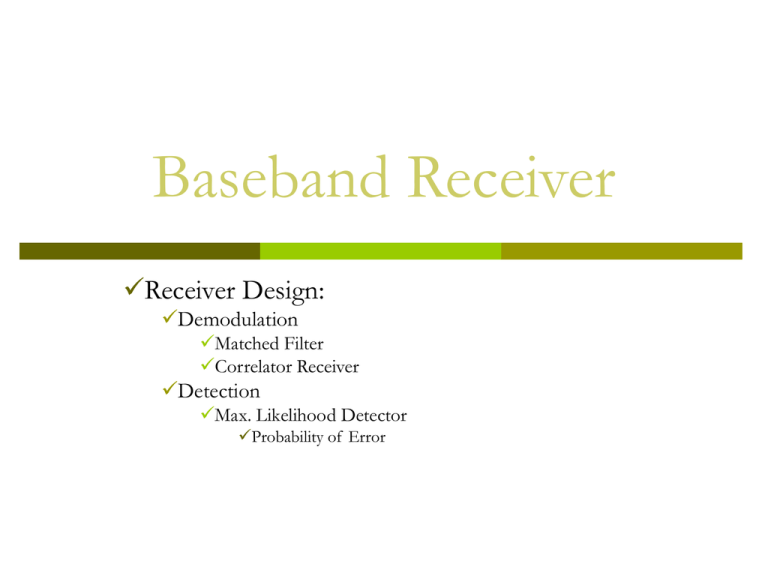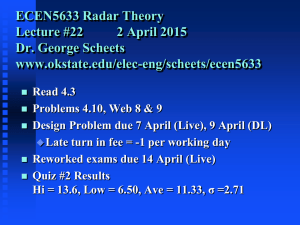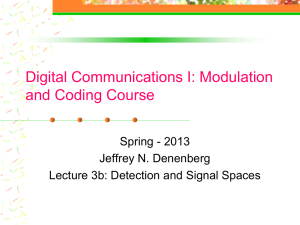Baseband Pulse Transmission
advertisement

Baseband Receiver
Receiver Design:
Demodulation
Matched Filter
Correlator Receiver
Detection
Max. Likelihood Detector
Probability of Error
Transmit and Receive Formatting
Sources of Error in received Signal
Major sources of errors:
Thermal noise (AWGN)
disturbs the signal in an additive fashion (Additive)
has flat spectral density for all frequencies of interest (White)
is modeled by Gaussian random process (Gaussian Noise)
Inter-Symbol Interference (ISI)
Due to the filtering effect of transmitter, channel and receiver,
symbols are “smeared”.
Receiver Structure
AWGN
DEMODULATE & SAMPLE
RECEIVED
WAVEFORM
TRANSMITTED
WAVEFORM
FREQUENCY
DOWN
CONVERSION
FOR
BANDPASS
SIGNALS
RECEIVING
FILTER
EQUALIZING
FILTER
DETECT
SAMPLE
at t = T
THRESHOLD
COMPARISON
COMPENSATION
FOR CHANNEL
INDUCED ISI
OPTIONAL
ESSENTIAL
Demodulation/Detection of digital signals
MESSAGE
SYMBOL
OR
CHANNEL
SYMBOL
Receiver Structure contd
The digital receiver performs two basic functions:
Why demodulate a baseband signal???
Demodulation
Detection
Channel and the transmitter’s filter causes ISI which “smears”
the transmitted pulses
Required to recover a waveform to be sampled at t = nT.
Detection
decision-making process of selecting possible digital symbol
Important Observation
Detection process for bandpass signals is similar to that
of baseband signals. WHY???
Received signal for bandpass signals is converted to
baseband before detecting
Bandpass signals are heterodyned to baseband signals
Heterodyning refers to the process of frequency conversion
or mixing that yields a spectral shift in frequency.
For linear system mathematics for detection remains
same even with the shift in frequency
Steps in designing the receiver
Find optimum solution for receiver design with the following
goals:
1.
2.
Maximize SNR
Minimize ISI
Steps in design:
Model the received signal
Find separate solutions for each of the goals.
Detection of Binary Signal in Gaussian Noise
The recovery of signal at the receiver consist of two parts
Filter
Reduces the received signal to a single variable z(T)
z(T) is called the test statistics
Detector (or decision circuit)
Compares the z(T) to some threshold level 0 , i.e.,
H1
z(T )
H0
0
where H1 and H0 are the two
possible binary hypothesis
Receiver Functionality
The recovery of signal at the receiver consist of two parts:
1.
Waveform-to-sample transformation
Demodulator
followed by a sampler
At the end of each symbol duration T, pre-detection point yields a sample
z(T), called test statistic
z(T ) ai (t ) n0 (t ) i 1,2
Where ai(T) is the desired signal component,
and no(T) is the noise component
2.
Detection of symbol
Assume
is linear
that input noise is a Gaussian random process and receiving filter
2
1
1 n0
p(n0 )
exp
0 2
2 0
Finding optimized filter
for AWGN channel
Assuming Channel with response equal to
impulse function
Detection of Binary Signal in Gaussian Noise
For any binary channel, the transmitted signal over a symbol interval
(0,T) is:
s0 (t ) 0 t T
si (t )
s1 (t ) 0 t T
for a binary 0
for a binary1
The received signal r(t) degraded by noise n(t) and possibly degraded
by the impulse response of the channel hc(t), is
r (t ) si (t ) * hc (t ) n(t )
i 1,2
Where n(t) is assumed to be zero mean AWGN process
For ideal distortionless channel where hc(t) is an impulse function and
convolution with hc(t) produces no degradation, r(t) can be
represented as:
r (t ) si (t ) n(t ) i 1,2
0t T
Design the receiver filter to maximize the SNR
Model the received signal
si (t )
r (t ) si (t ) hc (t ) n(t )
r (t )
hc (t )
n(t )
AWGN
Simplify the model:
Received signal in AWGN
Ideal channels
hc (t ) (t )
r (t )
si (t )
n(t )
AWGN
r (t ) si (t ) n(t )
Find Filter Transfer Function H0(f)
Objective: To maximizes (S/N)T and find h(t)
Expressing signal ai(t) at filter output in terms of filter transfer function H(f)
ai (t ) H ( f ) S ( f ) e j 2ft df
where H(f) is the filter transfer funtion and S(f) is the Fourier transform of input signal s(t)
If the two sided PSD of i/p noise is N0/2
Output noise power can be expressed as:
N0
2
2
0
Expressing (S/N)T :
S
N T
| H ( f ) |2 df
H ( f ) S( f ) e
N0
2
j 2fT
2
df
| H ( f ) |2 df
For H(f) = Hopt (f) to maximize (S/N)T use Schwarz’s Inequality:
f1 ( x) f 2 ( x)dx
2
f1 ( x) dx
2
f 2 ( x) dx
Equality holds if f1(x) = k f*2(x) where k is arbitrary constant and * indicates
complex conjugate
Associate H(f) with f1(x) and S(f) ej2 fT with f2(x) to get:
2
H ( f ) S( f ) e
j 2fT
2
2
df H ( f ) df
Substitute yields to:
2
S
N T N 0
2
S ( f ) df
2
S ( f ) df
Or
2E
S
max
N0
N T
and energy E of the input signal s(t):
E
2
S ( f ) df
Thus (S/N)T depends on input signal energy
and power spectral density of noise and
NOT on the particular shape of the waveform
2E
S
Equality for
holds for optimum filter
max
transfer function H0(f) N T N 0
such that:
H ( f ) H ( f ) kS * ( f ) e j 2fT
0
1
h(t )
kS * ( f )e
j 2fT
(3.55)
For real valued s(t):
kS (T t ) 0 t T
h(t )
else where
0
The impulse response of a filter producing maximum output
signal-to-noise ratio is the mirror image of message signal s(t),
delayed by symbol time duration T.
The filter designed is called a MATCHED FILTER
kS (T t ) 0 t T
h(t )
else where
0
Defined as:
a linear filter designed to provide the maximum
signal-to-noise power ratio at its output for a given
transmitted symbol waveform
Matched Filter Output of a rectangular
Pulse
Replacing Matched filter with Integrator
Correlation realization of Matched filter
A filter that is matched to the waveform s(t), has an impulse response
0t T
kS (T t )
h(t )
else where
0
h(t) is a delayed version of the mirror image (rotated on the t = 0 axis) of
the original signal waveform
Signal Waveform
Mirror image of signal
waveform
Impulse response of
matched filter
Correlator Receiver
This is a causal system
a system is causal if before an excitation is applied at time t = T, the response is
zero for - < t < T
The signal waveform at the output of the matched filter is
t
z (t ) r (t ) * h(t ) r ( )h(t )d
0
Substituting h(t) to yield:
z (t )
When t=T
t
0
t
0
r ( ) sT (t )d
r ( ) sT t d
z(t ) 0T r ( ) s( )d
So the product integration of rxd signal with replica of transmitted waveform s(t) over one symbol interval is
called Correlation
Correlator versus Matched Filter
The functions of the correlator and matched filter
The mathematical operation of Correlator is correlation, where a signal is correlated
with its replica
Whereas the operation of Matched filter is Convolution, where signal is convolved
with filter impulse response
But the o/p of both is same at t=T so the functions of correlator and matched filter is
same.
Correlator
Matched Filter
Implementation of matched filter
receiver
Bank of M matched filters
s (T t )
*
1
z1 (T )
r (t )
sM (T t )
*
zM
z1
z
z M
(T )
Matched filter output:
z Observation
vector
zi r (t ) si (T t ) i 1,...,M
z ( z1 (T ), z2 (T ),...,zM (T )) ( z1 , z2 ,..., zM )
Implementation of correlator
receiver
Bank of M correlators
s 1 (t )
T
z1 (T )
0
r (t )
s
M
(t )
T
0
z1
z M
z
zM (T )
z ( z1 (T ), z2 (T ),...,zM (T )) ( z1 , z2 ,..., zM )
T
zi r (t )si (t ) dt
0
i 1,...,M
Correlators output:
z Observation
vector
Example of implementation of
matched filter receivers
s1 (t )
Bank of 2 matched filters
A
T
0
T
z1 (T )
A
T
t
r (t )
0
T
s2 (t )
0
A
T
0
T
t
A
T
T
z1
z 2
z2 (T )
z
z
Detection
Max. Likelihood Detector
Probability of Error
Detection
Matched filter reduces the received signal to a single variable z(T), after which the detection
of symbol is carried out
The concept of maximum likelihood detector is based on Statistical Decision
Theory
It allows us to
formulate the decision rule that operates on the data
optimize the detection criterion
H1
z(T )
H0
0
Probabilities Review
P[s0], P[s1] a priori probabilities
These probabilities are known before transmission
P[z]
probability of the received sample
p(z|s0), p(z|s1)
conditional pdf of received signal z, conditioned on the class si
P[s0|z], P[s1|z] a posteriori probabilities
After examining the sample, we make a refinement of our previous
knowledge
P[s1|s0], P[s0|s1]
wrong decision (error)
P[s1|s1], P[s0|s0]
correct decision
How to Choose the threshold?
Maximum Likelihood Ratio test and Maximum a posteriori (MAP) criterion:
If
p(s0 | z) p(s1 | z) H0
else
p(s1 | z) p(s0 | z) H1
Problem is that a posteriori probabilities are not known.
Solution: Use Bay’s theorem:
p( z | s ) p(s )
i
i
p(s | z)
i
p( z)
p( z | s1 )P(s1 )
P( z)
H1
H0
p( z | s0 )P(s0 )
P( z)
H1
p( z | s1)P(s1)
This means that if received signal is positive, s1 (t) was sent, else
s0 (t) was sent
H0
p( z | s0 )P(s0 )
Likelihood of So and S1
1
MAP criterion:
L( z)
p( z | s1)
p( z | s0 )
H1
H0
P(s0 )
P(s1 )
likelihoodratiotest (LRT )
When the two signals, s0(t) and s1(t), are equally likely, i.e., P(s0) = P(s1) = 0.5, then
the decision rule becomes
L( z)
p( z | s1)
p( z | s0 )
H1
H0
1 max likelihoodratiotest
This is known as maximum likelihood ratio test because we are selecting
the hypothesis that corresponds to the signal with the maximum likelihood.
In terms of the Bayes criterion, it implies that the cost of both types of error is the
same
Substituting the pdfs
H0 :
H1 :
2
1
1 z a0
p( z | s0 )
exp
0 2
2 0
2
1
1 z a1
p( z | s1 )
exp
0 2
2 0
1
2 H1
z a1
exp
2
2 o
0 2
p ( z | s1 )
L( z )
1
1
p ( z | s0 )
1
1
2
z a0
exp
2
H0
0 2
2 0
H0
H1
1
Hence:
z (a1 a0 )
(a12 a02 )
exp
1
2
2
0
2 0
Taking the log, both sides will give
H1
z (a1 a0 ) (a12 a02 )
ln{L( z )}
0
2
2
0
2 0
H0
H1
z (a1 a0 ) (a12 a02 ) (a1 a0 )(a1 a0 )
2
2
0
2 0
2 02
H0
Hence
H1
02 (a1 a0 )(a1 a0 )
z
2 02 (a1 a0 )
H0
H1
(a1 a0 )
z
0
2
H0
where z is the minimum error criterion and 0 is optimum threshold
For antipodal signal, s1(t) = - s0 (t) a1 = - a0
H1
z
0
H0
Probability of Error
Error will occur if
s1 is sent s0 is received
P( H 0 | s1 ) P(e | s1 )
P(e | s1 )
0
p( z | s1 ) dz
s0 is sent s1 is received
P( H1 | s0 ) P(e | s0 )
P(e | s0 )
p( z | s0 ) dz
0
The total probability of error is sum of the errors
2
PB P(e, si ) P(e | s1 ) P( s1 ) P(e | s0 ) P( s0 )
i 1
P( H 0 | s1 ) P( s1 ) P( H1 | s0 ) P( s0 )
If signals are equally probable
PB P( H 0 | s1 ) P( s1 ) P( H1 | s0 ) P( s0 )
1
P( H 0 | s1 ) P( H1 | s0 )
2
Hence, the probability of bit error PB, is the probability that an incorrect
hypothesis is made
Numerically, PB is the area under the tail of either of the conditional
distributions p(z|s1) or p(z|s0)
PB
0
P ( H 1 | s0 ) dz
p ( z | s0 ) dz
0
1 za
1
0
exp
0
2
2 0
0
2
dz
2
1
1 z a0
dz
PB
exp
0
2
2 0
0
z a0
du
1
let u
then
0 du dz
0
dz 0
( a1 a0 )
2 0
u2
1
exp du
2
2
The above equation cannot be evaluated in closed form (Q-function)
Hence,
a1 a0
PB Q
2 0
Co-error function
Q(x) is called the complementary error function or
co-error function
Is commonly used symbol for probability
Another approximation for Q(x) for x>3 is as follows:
Q(x) is presented in a tabular form
Co-error Table
Imp. Observation
To minimize PB, we need to maximize:
or
a1 a0
2 0
a1 a0 2
02
Where (a1-a2) is the difference of desired signal components at filter output at
t=T, and square of this difference signal is the instantaneous power of the
difference signal
a1 a0 Ed
S
2
N0
N
T
0
2
1 2 Ed
SNR
Q
PB Q
2 N
2
0
2
2 Ed
N0
Ed
Q
2N
0
i.e. Signal to Noise Ratio









